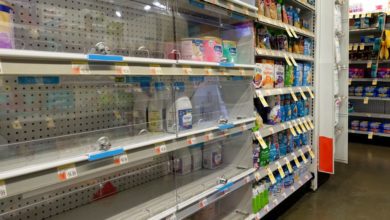COVID Could Be Surging in the U.S. and We Might Not Know It

TAs testing effort wanes, there has been a rise in Covid cases across the U.S. This raises the possibility of a new major outbreak. It is possible the nation could be suffering from a massive surge at the moment, but we may not know.
For rapid response to Covid epidemics, it is important to perform testing and sequence viral DNA. As the country attempts to heal from the pandemic the need for lab-based testing has dropped and the federal funding priorities have changed. The change has forced some testing centers to shutter while others have hiked up prices in response to the end of government-subsidized testing programs. If they do decide to take the test, people are more likely to rely on home rapid tests. The results of these tests are often not reported to the public, so it is difficult for health officials to know how prevalent this virus really is.
“There’s always more spread than we can detect,” said Abraar Karan, an infectious disease physician at Stanford University. “That’s true even more so now than earlier in the pandemic.”
Despite groundbreaking scientific advances like vaccines and antivirals, public health experts say the U.S.’s Covid defenses appear to be getting weaker as time goes on, not stronger.
“We’re in a worse position,” said Julia Raifman, an assistant professor of health law, policy and management at Boston University School of Public Health. “We’ve learned more about the virus and how to address it, and then we haven’t done what we need to do to address it.”
The Centers for Disease Control and Prevention started to rely on ICU capacity and hospital admissions in February for community-level risk assessment. It was a departure from the previous system that relied on Covid counts and positive test percentages to determine community-level risk. Several states including Arizona, Hawaii and Nevada have stopped reporting Covid data daily to the CDC. This makes it harder to track the progress of the pandemic.
The CDC states that the vast majority of Americans are still at low risk. This is a misleading statement, according to public health experts. Hospitalizations and even death can occur as soon as a person has contracted the infection. Without widespread testing, that could make it impossible to detect a surge until it’s too late to do anything about it.
“CDC is understating and downplaying cases,” said Gregg Gonsalves, an infectious disease expert at Yale’s School of Public Health. “Their alarm bells won’t go off until we see a rise in hospitalizations and deaths, which are lagging indicators.”
Transmissible Variant
Omicron is milder in people who are vaccinated. However, the epidemic caused so many hospitalizations, that they broke all previous records. This variant also contributed to a record-breaking number of children being admitted to the hospital. During the New York surge, Blacks were twice as likely to be hospitalized than Whites. The effectiveness of vaccines in controlling severe illness, if not all cases is impressive. That’s why the metrics moved toward hospitalizations when assessing the status of the virus. However, it is impossible to identify all cases. Experts agree that it’s crucial to keep track of them to ensure the protection of vulnerable populations and to respond quickly to any new outbreaks.
Recent weeks have seen cases rise in New York, Massachusetts, and Chicago. However, conflicting messages in the public domain has created confusion. While national leaders are generally declaring victory, some local governments have begun to warn against overreacting. New York City delayed lifting a mask mandate for kids under 5 years of age due to rising cases and the city’s health commissioner recommended New Yorkers return to masking indoors.
Even so, New York is vastly different from when it was at the beginning of previous surges. Long testing lines are gone and antigen test supplies have sold out. Pop-up testing facilities, which once were a mainstay of pandemics, are slowly disappearing across the nation. Although state-run facilities for testing have been operating in certain regions, those without insurance face high costs. As of March 22, U.S. Health Resources and Services Administration no longer accepts reimbursement claims from healthcare providers regarding Covid testing.
At-home rapid tests have also increased in popularity. The problem is, the CDC does not require people to report positive at-home test results so it’s rare the results of at-home tests are factored into public health data.
“We are probably underestimating the number of infections we are having now because many of the infections are either without symptoms or minimally symptomatic and you will miss people that do it at home,” Anthony Fauci, the top medical adviser to President Joe Biden, told Bloomberg TV on Wednesday.
In New Jersey, for example, Stacy Flanagan, the director of health and human services for Jersey City, said that in the last three months she’s had just two people call to report positive at-home tests. According to data from the health department, there are an average 64 cases per day in this city. That’s almost double the number of daily cases reported a month ago.
“We’ve heard from only a handful of conscientious people who call us and say, ‘I’ve done a home test and it’s positive,’” said Dave Henry, the health officer for more than a dozen towns in Monmouth County, New Jersey.
It is up to public health specialists to combine data from different sources. For Rick Bright, a virologist and CEO of the Rockefeller Foundation’s Pandemic Prevention Institute, that means using the CDC data as well as a number of other sources to understand Covid’s spread. “Unfortunately, we still have to go to a handful of sites to try to patch together what’s really happening across the country.”
In order to determine the level of virus in a given community, other metrics like wastewater surveillance or air sampling could be helpful. For weeks, sewer data has shown cases are increasing in some regions of the U.S. — foreshadowing the uptick in positives that places like New York and Massachusetts are now seeing.
In the nation’s capital, more than 50 people who attended the elite Gridiron Club dinner on April 2 have tested positive for the coronavirus, the Washington Post reported — at least 8 percent of those who attended. U.S. Attorney General, Commerce Secretary, and Jill Biden (the sister of President) are among the list.
Speaker of the House Nancy Pelosi, who didn’t attend the dinner, has also tested positive, raising concern about time she spent in proximity to President Biden prior to her diagnosis.
Home testing
The White House maintains there’s enough data about Covid in circulation to catch the next surge. Tom Inglesby, senior policy advisor for Biden’s Covid-19 Response Team, said the CDC gets 850,000 lab-based test results every day, which he believes is sufficient to detect trends in the positivity rate and variant prevalence.
“It is true that there is a larger shift now to switch to over-the-counter testing, that’s definitely happening,” Inglesby said during a panel discussion. “There are various efforts underway to try to assess whether people might be willing to voluntarily report some fraction of those tests that are being performed at home.” One biotech company, Ellume, has rolled out an at-home test and app that automatically reports positive tests to the CDC through a secure, HIPAA-compliant connection.
The CDC pledged that it would increase its surveillance of wastewater. Although the agency doesn’t have access to data for every state yet, it could still use some sampling that is already being done. Without additional funding, environmental surveillance and other tools for tracking Covid may be in danger. On Tuesday, lawmakers reached an agreement to re-allocate $10 billion to pandemic preparedness, which press secretary Jen Psaki said would fund “the most immediate needs” such as antivirals and tests. However, the Senate has not yet approved this bill.
“The information we are getting from the CDC is going to be less reliable, more spotty, and lose momentum,” Bright said. “There’s really big concerns about the lack of sustainable financing to keep the momentum going and finish the job for the surveillance we’re building for pandemic prevention.”
Perhaps there is a lesson to be learned from the 1918 flu pandemic. Public sentiment changed and some health measures were removed after cases began to decline following the second wave of the flu virus. A government-funded study found that New York City was hit by a fourth influenza wave in 1919. This caused deaths to rise higher than during previous waves.
“These late waves of the pandemics are sometimes the deadliest because people have given up,” said Gonsalves from Yale.
Here are more must-read stories from TIME





